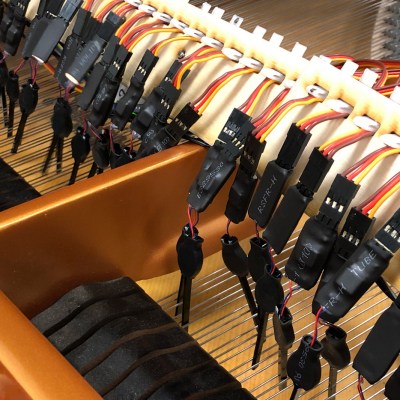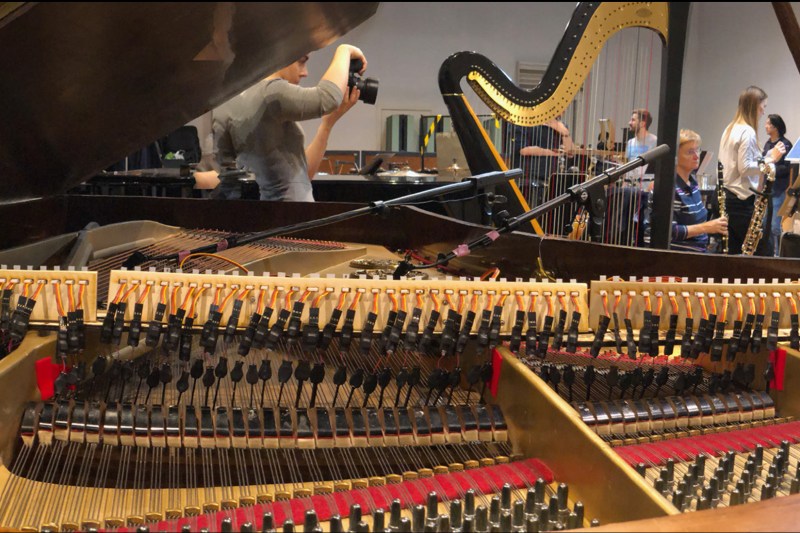It’s not every day we see a grand piano with a Raspberry Pi inside, let alone one with 96 motors, but sometimes we get lucky. The contraption in question is one developed by [Konstantin Leonenko], as part of a collaboration with composer [Patricia Alessandrini] for a piece she created inspired by Ada Lovelace. Specifically, [Patricia] was inspired by Ada’s idea that an “analytical machine” would, someday, be able to create music on its own. [Konstantin] and [Patricia] worked together to make a machine that would learn from it’s human co-performers and create music with them.
 Their creation, rather than just one tricked-out keyboard, is actually a portable attachment that can be easily fitted to any grand piano. Each of the device’s 96 motors drives a plastic “finger” that excites the piano’s strings. The result is a sound unlike any other — and you really need to experience it so click through that link at the top for the demo video.
Their creation, rather than just one tricked-out keyboard, is actually a portable attachment that can be easily fitted to any grand piano. Each of the device’s 96 motors drives a plastic “finger” that excites the piano’s strings. The result is a sound unlike any other — and you really need to experience it so click through that link at the top for the demo video.
Rather cleverly, the fingers are designed such that their dynamics help to mask the sound of the motor (a must for performances) while simultaneously enhancing the string’s timbre. Like any project, this one went through a number of iterations over the two-year design process, and even spun off into an entirely new, glove-based version.
We’ve seen some awesome music tech hacks, and this one fits right in with the rest. It’s always exciting to see an instrument as ubiquitous as the piano be used in new and refreshing ways. Be sure to check out the link at the top for a video of this incredible instrument in action!
















How is the third string in the triplet supposed to be excited with no motor drive? All in all, I do not like this particular design of vibrating motors hanged by their connectors, exciting 2 of 3 strings.
Probably through sympathetic vibration in response to the other two.
Wasn’t this featured less than a week ago??
https://hackaday.com/2021/02/11/tiny-motors-enable-experimental-piano-performance/
Amost…. different implementation of a similar idea
I was just about to say the same thing. Seemed very fresh in the back of my mind as well and thought it was the same person.
Awesome. I absolutely hate the sound this makes, but it is awesome.
I agree. I was hoping for something like the instrument that Fred Hoyle describes in October the First is Too Late. Read the story in 1980 and didn’t like it for a variety of reasons but I still remember the piano he described. In it, the sound is produced by continuously hammering on the strings and the volume of each note is controlled both by the key velocity and position. In other words you could strike the key and it would sound like a piano but pressing or releasing the key slowly would also make the tone crescendo or decrescendo. Don’t know if a human would have enough control to actually play the thing as described but it would make for a cool synthesized sound.
Found this on Youtube, not linked by the main page pointed by the article.
https://www.youtube.com/watch?v=1Pxtch_oDp4
thank you! I haven’t seen this registration myself :)
“The result is a sound unlike any other”
Yep, sure is.
Sure, it is art. But from a technological point of view, I don’t like it.
I too am ambivalent about this.. Artsy people gonna be artsy. Not all art is good, IMHO, but it’s all art, as anyone is free to call anything they want art.
The article quote “It’s always exciting to see an instrument as ubiquitous as the piano be used in new and refreshing ways” should be rephrased as a personal opinion rather than an established fact. This does not excite me, but I’m a STEM guy too, as opposed to STEAM.
As long as it isn’t on my lawn…
With 96 motors can it play “96 Tears”?
I think this is the wrong approach. A better approach is to use magnetic pickups and magnetic actuators that directly pull on the strings, with an amplifier between the pickup and the actuator. Piezoelectric beepers do something similar, using an electrically isolated portion of the piezo disc as feedback for the electronic oscillator. This might even be an acceptable application for the LM386. Anyway, this would produce a continuous pure tone, not a hot jangly mess that vibration motors do.
What about using an ebow (https://www.ebow.com/home.php) to excite the strings, triggered by position from the muting pads. Perhaps removing the hammers also. That would produce a pleasant continuous sound and still be played like a piano.
This is exactly what I was suggesting in my comment above, where I suggested using a pickup, amplifier, and an “actuator” to send this back to the string! Seems like anything I can think of doing has already been done.
the design you have in mind has been implemented by Andrew McPherson: http://instrumentslab.org/research/mrp.html
However EM excitation results in a very different, organ-like timbre with very slow attack and the system is order of magnitude heavier and more expensive.
The trembling, harpsichord-like timbre as well as portability was what the composer was seeking – hence the resulting design.
If you like this sound, look up John Cage’s music.